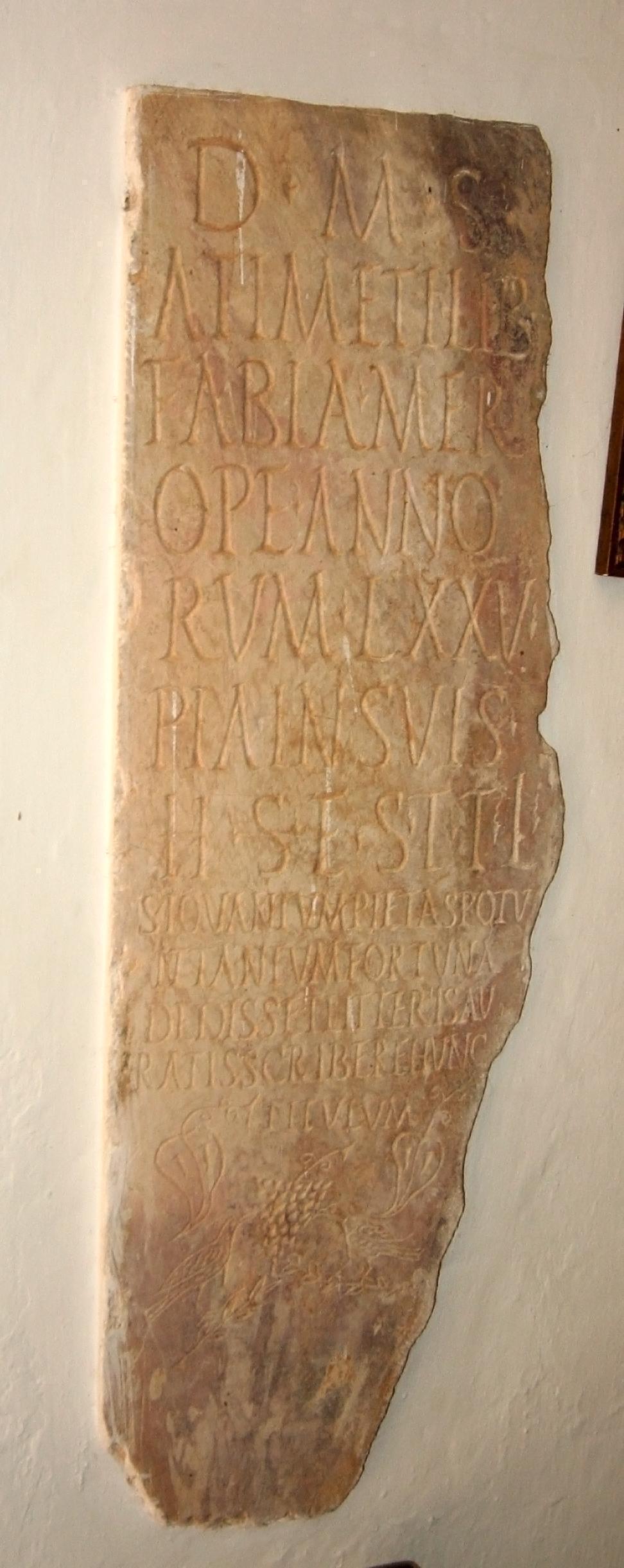Epitaph of Fabia Merope
Reference AE 1975, 503 | Description | Lyrics | Location | Chronology | Epigraphic edition | Translation | Apparatus | Comentary | Type of verse | Text divided into verses and metric signs | Images | Bibliography | Link to DB | Author |
Epitaph of Fabia Merope
Description
- Idno filename 22/01/0020
- Type of inscription: Sepulcralis
- Support: Stela
- Material: Marble Material Description: Pink colour.
- Conservation status: Built into a wall and jutting out 1.5. The stone is broken on the right-hand side and the lower part, prior to the inscription of the text, given that it is adapted to the available dimensions.
- Dimensions height/width/depth (cm): 88/30/3
-
Epigraphic field:
- Layout: "Ordinatio" good. In the "praescriptum", interpunctum in the form of "hedera" with zigzagging peduncle, except one on l. 7 which is lanceolate; "scriptio continua" in the "carmen". Whose lines on the other hand have no correspondence with the verse.
- Decoration: Under the text, two large ivy leaves and two doves perched on olive branches, pecking at a bunch of grapes.
- Preserved
Lyrics
- Font:Libraria
- Letter size:5 in the praescriptum and 2/2.5 in the carmen. cm
Location
- Place of discovery: Found in 1975 in Peñaflor, the former Celti.
- Geolocation
- Conservation location: Conserved in Peñaflor, built into a wall inside the Ermita de Ntra. Señora de Villadiego.
- Location with Modern Nomenclature España / Sevilla / Peñaflor
- Location with Old Nomenclature Hispania / Baetica / Hispalensis / Celti
Chronology
- Inscription's dating: Between year 150 and year 250
- Dating explanation: From the orthography, decoration and structure of the piece, it can be dated to the 2nd-3rd c. AD.
Type of verse
- Type of verse: Dactílico (dístico elegíaco)
- Verse/line correspondence: No
- Prose/verse distinction: Si
Epigraphic edition
D(is) ▴ M(anibus) ▴ s(acrum) ▴
Atimeti ▴ lib(erta) ▴
Fabia ▴ Mer-
ope ▴ anno-
5 rum ▴ LXXV ▴
pia ▴ in suis ▴
h(ic) ▴ s(ita) ▴ e(st) ▴ s(it) ▴ t(ibi) ▴ t(erra) ▴ l(evis) ▴
si quantum pietas potu-
it tantum fortuna
10 dedisset litteris au-
ratis scribere(m) hunc
titulum
Text divided into verses and metric signs
Si quantum pietas potuit tantum fortuna dedisset, ll|l/kk|l/kk|l/l|ll|lkk|l~
litteris auratis scriberem hunc titulum. lkl|ll|l||lkkH|lkk|~
Translation
“Consecrated to the Manes. Fabia Merope, freedwoman of Atimetus, of 75 years, devoted to her own. She lies buried here; may the earth rest lightly on you. If fortune had let me do as much as affection allowed, I would have inscribed this with letters of gold.”
Bibliography
Chic 1975, 359–361 (AE 1975, 503); Susini 1975, 265; Correa 1976, 367–369 (AE 1976, 281); González Fernández, CILA II, 175, cum im. phot. fig. 90; Keay – Creighton – Remesal 2001, 184– 185; Fernández Martínez – Carande, CLEB, SE10, cum im. phot, quae in linguam Hispanicam verterunt, Cugusi 2012, 8. – Cf. Cugusi 1980-81a, 8; Hernández Pérez 2001a, 182, 185–186.
Comentary
Funerary carmen in honor of the freedwoman Fabia Merope, dedicated by her patronus. The Greek name of the latter, Atimetus (cf. CIL II, 532; CIL 1800; CIL 4089), seems to show that he was also a freedman. The cognomen Merope is much rarer: there is only one Gaius Iulius Merope in Tarragona (CIL II, 4374), also a freedman. The poem consists of one elegiac distich, whose hexameter has 7 feet instead of 6, according to Correa 1976, 367, because of the introduction of tantum, innecesario sintáctica y semánticamente, pero justificado por la frecuencia de la correlación ‘quantum – tantum’; the pentameter presents a hiatus and shortening of a final syllable in unstressed position. In terms of the language, worthy of note is the normal loss of the final –m in the subjunctive scriberem (cf. Carnoy 1971, 199 ff.; Mariner 1952, 35-42). This is more likely than the interpretation of this form as an infinitive dependent on dedisset (cf. Correa 1976, 378). The carmen includes the topos of the personal fortune of the dedicant being insufficient to offer the deceased the homage which his affection for her warranted, cf. CLE 1086,7-10; the topos of the litterae auratae appears, for example, in CLE 229,3.
The decorative motifs appear to represent the banquet of the soul in the next world, as a symbol of the triumph over death (cf. Cumont 1966, 419 and García y Bellido 1949, 325). This same motif is found in other prose inscriptions from Peñaflor, and could well come from the same workshop.
Author
- Author:R. Carande Herrero, C. Fernández Martínez
- Last Update2024-04-03 18:13:27
- Autopsy date:2002
You can download this






